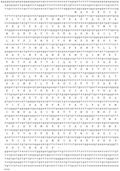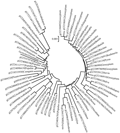 Author
Author  Correspondence author
Correspondence author
Plant Gene and Trait, 2012, Vol. 3, No. 1 doi: 10.5376/pgt.2012.03.0001
Received: 05 Nov., 2010 Accepted: 30 Nov., 2011 Published: 05 Dec., 2011
Liu et al., 2011, Cloning and sequence analysis of Actin gene from Guzmania, Plant Gene and Trait, Vol.3, No.1 1-5 (doi: 10.5376/pgt.2012.03.0001)
As a house keeping gene, Actin was often used as inner control in quantitative and semiquantitative PCR tests to determine relative expressive amount of target genes. Based on EST monoclones of Actin gene obtained from Guzmania full length cDNA library, its full length cDNA sequence was obtained by primer walking sequencing. The gene, named for Goactin1 (GenBank accession No. HQ184438), consisted of 1 625 bp cDNA sequence, 1 131 bp ORF (open reading frame) which encoded a protein with 377 amino acids residues, and a putative protein which was 41.7 kD at estimated molecular weight, 5.31 at isoelectric point and had a ‘actin superfamily’ conservative domain. The secondary structure of the protein was composed of random coil, alpha helix, extend strand and beta turn by SPOMA analysis. Furthermore, its tertiary structure was also build based on A chain of 2BTF. Through phylogenetic tree analysis, Goactin1 was gathered to the same group with Actin protein in Solanum tuberosum, Gossypium hirsutum, Nicotiana tabacum, Brachypodium sylvaticum, and Arabidopsis thaliana.
Plant actin was a kind of constitutive expression protein existed broadly, and had high conservatism (Meagher et al., 1999). Since Yan and Shi put forward that actin existed in higher plant for the first time in 1963(Yan and Shi, 1963), at present, actin had been discovered in pollen, root hair, stem cambium layer, stem phloem, vagina cell, leaf epidermal cell, tendril and endocarp tissues of higher plant (Kost et al., 1999), and also was multi-gene family like as that of animal and fungi (Zhang and Liu, 2006; Hussey et al., 2006). Plant actin involved in cell microfilaments formation, whereas, microfilaments were key components of cytoskeleton and participated in important physiological activities such as intracellular cytoplasmic streaming, keep of configuration, movement, division, differentiated, transport of substance, signal transduction and polarity constructing etc. (Ma et al., 2010). As house-keeping gene, Actin can express relative stably to some extent in tissues and cells and had many advantages such as constitutive expression, multiplication easily. Hence, like as other house-keeping genes included GAPDH, 18SrRNA, TBP and β-2-microglobulin, Actin often was used as inner reference in quantitative or semiquantitative PCR reaction to revise expression amount of target genes (Zhu et al., 2006; Yang et al., 2007; Liu, 2003).
Guzmania, belonged to Bromeliaceae, was native to tropics and suibtropics of American, and was superior quality potted flower plant in flower marketplace. At present, there was a lack of information in public about Guzmania Actin gene. Based on full length cDNA library constructed successfully in Guzmania ostara and plenty of EST sequences information were obtained by sequencing randomly on a large scale formerly, full length cDNA sequence of Actin gene was obtained, by Primer Walking sequencing to EST monoclones belonged to Actin gene. Finally, there was a bioinformatics analysis in-depth to the gene. The research laid a foundation to construction of quantitative and semiquantitative PCR technique in ornamental Bromeliaceae.
1 Results and Analysis
1.1 Cloning of Goactin1 gene
Through primer walking sequencing to EST monoclone: |ppfca0_001242.z1.scf|, which belonged to Actin gene, a 1 625 bp full length cDNA sequence was obtained, and named for Goactin1 (GenBank accession number: HQ184438). It had a 1 131 bp ORF (open reading frame) which encoded 377 amino acids (Figure 1).
 Figure 1 mRNA sequence and deduced amino acid sequence of Goactin1 gene |
1.2 Blast analysis of full length cDNA and putative amino acid sequence
Nucleotide-nucleotide blast analysis showed the full length cDNA sequence of Goactin1 gene had a very high homologue to Actin gene of Populus trichocarpa, Vigna radiata, Betula luminifera, Oryza sativa, Zea mays, Arabidopsis thaliana, Nicotiana tabacum, Gossypium hirsutum, Pisum sativum, Ricinus communis, Pyrus communis, Aegiceras corniculatum, Prunus salicina, Phaseolus vulgaris, Phalaenopsis sp, Picea abies, Larix gmelinii, Mimosa pudica, Diospyros kaki, Plantago major, Linum usitatissimum and Solanum tuberosum. And the homologue of Populus trichocarpa (XM_002311131, GENE: 7467546), Vigna radiata(AF143208.1) and Betula luminifera (FJ410442.1) was the highest, which reached 84 percent. Moreover, by comparing the deduced amino acid sequences (BlastP) with the protein data bank, the result showed that Goactin1 also had very high homologue to actin protein of many other species in the data bank. The maximum number of amino acid homologue was 99 percent from Ricinus communis(XP_002530711.1, EEF31665.1), Solanum tuberosum (CAA39280.1), Gossypium hirsutum (AAC31886.1), Populus trichocarpa (XP_002308365.1, XP_002322664.1, ABK92789.1, XP_002311167.1, EEE88534.1, XP_002316289.1, ABK92513.1, EEF02460.1), Caragana Korshinskii (ACK87035.1) and Nicotiana tabacum (ACH69153.1, CAA45149.1).
1.3 Characteristic analysis of Goactin1 protein
1.5 Molecular phylogenetic tree analyses of Goactin1
2 Discussion
3 Materials and Methods
3.2 Methods
And then, through Primer Walking sequencing to every single EST and contig in Hangzhou Genomics Institute, four full length cDNA sequences of Actin gene were obtained, one of which was analyzed and published in the paper, the rest would be published in other papers.
Some characters involved in cDNA sequence, amino acid sequence, conservative domain and genetic relationship, were analyzed by diversified bioinformatics methods, for instance, prediction of amino acid sequence by ExPASy combined with BlastP, multisequencing comparison of nucleotide and amino acid by Blast, estimation of protein molecular weight and isoelectric point by ProtParam, analysis of protein secondary structure by SPOMA, search of conservative domain used cdart program (NCBI), prediction of protein tertiary structure by ESyPred 3D and phylogenetic tree analyse by MEGA 4.0 combined with ClustalX (1.81) software.
Authors' contributions
Acknowledgements
References
Combet C., Blanchet C., Geourjon C., and Deléage G., 2000, NPS@: network protein sequence analysis, Tibs., 25(3): 147-150
http://dx.doi.org/10.1016/S0968-0004(99)01540-6
Hussey P.J., Ketelaar T., and Deeks M.J., 2006, Control of the Actin cytoskeleton in plant cell growth, Annu. Rev. Plant Biol., 57: 109-125
http://dx.doi.org/10.1146/annurev.arplant.57.032905.105206 PMid:16669757
Kost B., Mathur.J, and Chua N.H., 1999, Cytoskeleton in plant development, Curr. Opin. Plant Biol., 2(6): 462-470
http://dx.doi.org/10.1016/S1369-5266(99)00024-2
Lambert C., Leonard N., de Bolle X., and Depiereux E., 2002, ESyPred3D: Prediction of proteins 3D structures, Bioinformatics, 18(9): 1250-1256
Liu J.X., Shen F.Q., Tian D.Q., Zhang Z., Ge Y.Y., Shen X.L., Yu X.Y., and Wang W.Y., 2009,Construction of full-length cDNA library from floral organ and EST analysis in Guzmania, Fenzi Zhiwu Yuzhong (Molecular Plant Breeding), 7(6): 1137-1143
Liu J.Y., 2003, Real- Time PCR technique and its application in quantification of plant nucleic acid molecules, Acta Botanica Sinica, 45(6): 631-637
Ma X.F., Yu C.M., Tang S.W., Zhu A.G., Wang Y.Z., Zhu S.Y., Liu J.X., and Xiong H.P., 2010, Cloning and tissue expression of Actin1 gene in different fiber development phases of ramie [Boehmeria nivea (Linn.) Gaud], Zuowu Xuebao (ACTA AGRONOMICA SINICA), 36(1): 101-108
http://dx.doi.org/10.3724/SP.J.1006.2010.00101
Marchler-Bauer A., and Bryant S.H., 2004, CD-Search: protein domain annotations on the fly, Nucleic Acids Res., 32(W): 327-331
Marchler-Bauer A., Anderson J.B., Chitsaz F., Derbyshire M.K.,DeWeese-Scott C., Fong J.H., Geer L.Y., Geer R.C., Gonzales N.R., Gwadz M., He S., Hurwitz D.I., Jackson J.D., Ke, Z., Lanczycki C.J., Liebert C.A., Liu C., Lu F., Lu S., Marchler G.H., Mullokandov M., Song J.S., Tasneem A., Thanki N., Yamashita R.A., Zhang D., Zhang N., and Bryant S.H., 2009, CDD: specific functional annotation with the Conserved Domain Database, Nucleic Acids Res., 37(D): 205-210
Meagher R.B., McKinney E.C., Kandasamy M.K., 1999, Isovariant dynamics expand and buffer the responses of complex systems: The diverse plant Actin gene family, The Plant Cell, 11: 995-1006
http://dx.doi.org/10.2307/3870793
Yan L.F., and Shi D.Q., 1963, The presence of a contractile protein in higher plants, Shenghua Yu Shengwu Wuli Xuebao (Acta Biochim. Biophys. Sin.), 3(4): 490-495
Yang F.L., Yue H., Xie X.L., and Jia W.X., 2007, Development of real-time PCR assay for duck GAPDH gene, Xinan Minzu Daxue Xuebao • Ziran Kexue Ban (Journal of Southwest University for Nationalities⋅Natural Science Edition)), 33(1): 92-95
Zhang S.B., and Liu G.Q., 2006, Research advances in plant actin isoforms, Zhiwuxue Tongbao (Chinese Bulletin of Botany), 23(3): 242-248
Zhou H.F., Zhao W.L., and Yan L.F., 2001, Cloning and sequence analysis of Actin gene from Magnolia denudata Desr., Nongye Shengwu Jishu Xuebao (Journal of Agricultural Biotechnology), 9(3): 274-278
Zhu H., Li S., Zhao R.Q.,Wu Y.S., 2006, Cloning and sequencing of Panax notoginseng GAPDH, Xibei Zhiwu Xuebao (Acta Bot.Boreal.-Occident. Sin.), 26(7): 1316- 1319
. PDF(813KB)
. FPDF(win)
. HTML
. Online fPDF
Associated material
. Readers' comments
Other articles by authors
. Jianxin Liu
. Yaying Ge
. Danqing Tian
. Zhi Zhang
. Huaqiao Ding
. Fuquan Shen
. Weiyong Wang
Related articles
. Guzmania ( Guzmania Ruiz&Pav )
. Actin
. Clone
Tools
. Email to a friend
. Post a comment




